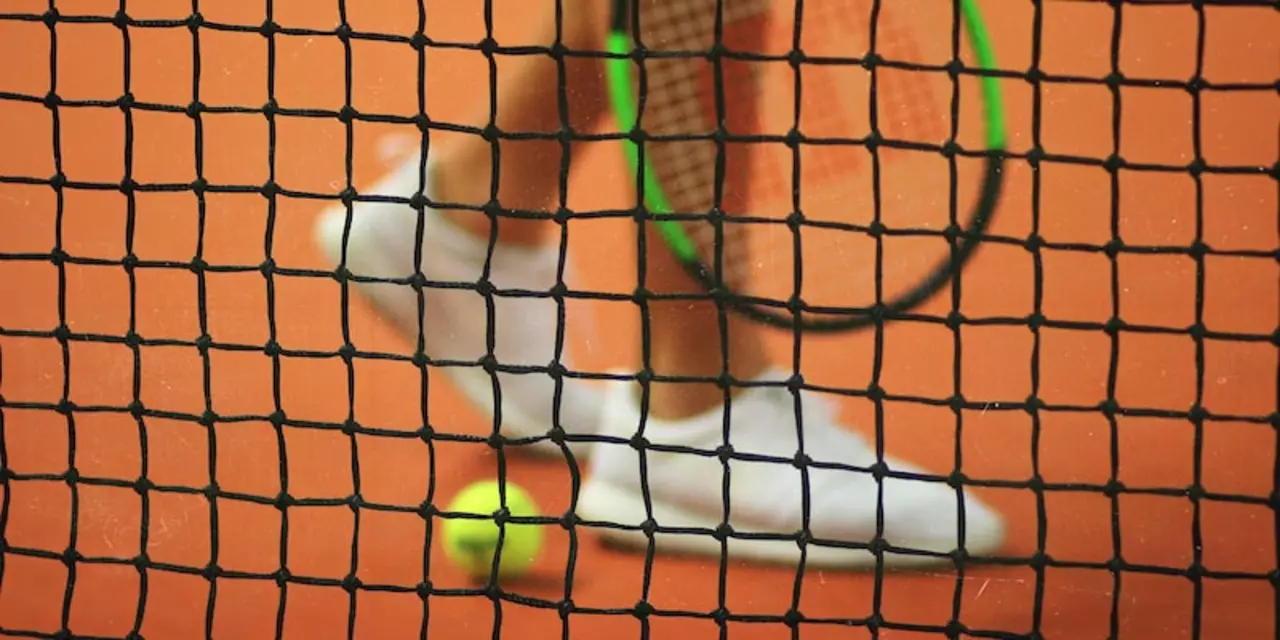Exploring the Physics of Tennis: Can a Tennis Racket Cross Over the Plane of the Net?
Tennis is a sport that has been around for centuries, and the physics of the game has been studied and analyzed for just as long. The way a tennis ball reacts when hit with a racket and the way a racket can move in different directions is a fascinating topic. One of the intriguing questions about the physics of tennis is whether a racket can cross over the plane of the net.
The physics behind the motion of a tennis racket is complex. A racket can move in three dimensions, which includes up and down, left and right, and forward and backward. The trajectory of the racket is determined by the speed of the swing, the angle of the racket face, and the spin and spin direction of the ball. When a racket is swung across the net, it can move in any direction, including over the plane of the net.
The main factor that determines whether a tennis racket can cross over the plane of the net is the speed of the swing. If the racket is swung fast enough, it can break through the plane of the net. The speed of the swing needs to be faster than the reaction time of the opponent, otherwise the opponent will be able to react and return the shot. The angle at which the racket face is pointing also plays a role in whether the racket will cross over the plane of the net.
The spin and spin direction of the ball also affect the motion of the racket. If the ball has a lot of spin, it will cause the racket to move in a different direction than it normally would. A spinning ball can also cause the racket to break through the plane of the net. The spin direction of the ball can also make it more difficult for the opponent to react, giving the player more time to cross the plane of the net with the racket.
The physics behind the motion of a tennis racket is complex, and it is possible for a racket to cross over the plane of the net. The speed of the swing, the angle of the racket face, and the spin and spin direction of the ball all play a role in whether a racket can cross over the plane of the net. With practice and experience, a player can learn to control the motion of the racket and cross the plane of the net successfully.
Examining the Rules of Tennis: Can a Tennis Racket Cross Over the Net?
Tennis is a popular and beloved sport that is enjoyed by millions of people around the world. With its rules and regulations, many players, beginners and pros alike, often wonder if a tennis racket can cross over the plane of the net.
The answer is yes, but it is not recommended. According to the official rules of tennis as set forth by the International Tennis Federation (ITF), a tennis racket can cross over the plane of the net. However, when this happens, the player who caused the racket to cross the net is automatically disqualified from the match.
Although a tennis racket is allowed to cross the plane of the net, it is not recommended. This is because when a racket crosses the plane of the net, it usually disrupts the game, and it can also lead to dangerous situations.
When a racket crosses the net, it usually disrupts the game in a manner that is unfavorable to both players. This is because when a racket passes over the net, it impedes the flow of the game and can cause a distraction to the players.
In addition, a tennis racket that crosses the plane of the net can also lead to dangerous situations. This is because when a racket passes over the net, it can hit the other player or a spectator.
Therefore, it is important to note that while a tennis racket is allowed to cross the plane of the net, it is not recommended. This is because it can lead to dangerous situations and disrupt the flow of the game.
It is important to remember that when playing tennis, it is essential to stay within the rules of the game. This means that players should not attempt to hit the ball over the net with their racket and should instead try to hit the ball just above the net.
Therefore, in conclusion, a tennis racket can cross the plane of the net, but it is not recommended. Players should instead focus on hitting the ball just above the net and should avoid attempting to hit the ball over the net with their racket.
Analyzing the Impact of Tennis Racket Design on Crossing the Net Plane
Tennis rackets have come a long way in recent years, but one question still remains: can a tennis racket really cross over the plane of the net? While it may seem like an impossible feat for a tennis racket, modern racket designs have made it possible. In this article, we'll explore the impact of design on crossing the plane of the net and the possible implications of such an achievement.
The Impact of Design on Crossing the Net Plane
Modern tennis rackets are designed with the goal of increasing aerodynamic efficiency and reducing drag. This is done by introducing features such as aerodynamic heads, larger frames, and lighter weight. These features help to create more power and control of the racket, allowing it to travel further and faster. By increasing the speed of the racket, it becomes possible to cross the plane of the net and hit the ball on the other side.
In addition to the design of the racket, the material used also has an impact on the racket's ability to cross the net plane. Many modern rackets are made from lightweight materials such as carbon fiber and graphite, which help to increase the speed of the racket and reduce the weight. This allows the racket to move faster and cross the plane of the net more easily.
Implications of Crossing the Net Plane
Crossing the plane of the net with a tennis racket has numerous implications for the sport. Advanced players will be able to hit shots that are more powerful and precise, and the overall pace of the game could increase significantly. Additionally, this could open up new strategies for players, such as hitting the ball across the net at various angles. Finally, crossing the net plane could provide an advantage to experienced players, as they would be able to hit shots that are more difficult for less experienced players to return.
Conclusion
Crossing the plane of the net with a tennis racket is certainly possible with modern racket designs. By increasing the speed of the racket and using lightweight materials, it is possible to create a racket that can cross the net plane. This has many implications for the sport, including increased power and precision, as well as new strategies for advanced players. Ultimately, crossing the net plane could be a game-changer for tennis, and it's something all players should strive to master.
Unveiling the Myths Surrounding a Tennis Racket Crossing the Plane of the Net
Tennis is a game of skill and precision. The aim of the game is to hit the ball over the net without it touching the ground. However, there have been occasions where the ball has been hit over the net and the racket has gone over the plane of the net as well. Is this possible?
The answer to this question is yes, it is possible for a tennis racket to cross over the plane of the net. This can occur if the player is trying to hit a particularly difficult shot, or even if the player is attempting to return a powerful shot from their opponent. In this situation, the player's racket may reach a point where it is higher than the net, and if the player is able to make contact with the ball, the racket may cross over the plane of the net.
However, there are some myths surrounding this phenomenon. Some people believe that it is not possible for a racket to cross the plane of the net and that it is purely a trick of the eye. This is simply not true. A racket can indeed cross the plane of the net in certain situations, as long as the player is able to make contact with the ball.
Another myth is that a player can be penalized for crossing the plane of the net with their racket. This is also untrue, as the rules of tennis do not specify any punishment for this action. If a player does make contact with the ball and their racket crosses the plane of the net, it is simply considered a legal shot and play will continue as normal.
Finally, some people believe that crossing the plane of the net with a racket is an illegal move and should not be attempted. This is not true either. As long as the player is able to make contact with the ball, crossing the plane of the net is a perfectly legal move and can be an effective way to return a difficult shot.
In conclusion, it is possible for a tennis racket to cross over the plane of the net during play. Contrary to popular belief, it is not an illegal move and is often an effective way to return a difficult shot. Players should not be afraid to attempt this maneuver, as long as they are able to make contact with the ball.
Understanding the Consequences of a Tennis Racket Crossing the Plane of the Net
Tennis is a sport that requires precision and accuracy in order to score points. A player’s ability to hit the ball within the boundaries of the court is essential for success. But what happens if a tennis racket crosses the plane of the net?
When a tennis racket crosses the plane of the net, it is an illegal move and is considered a fault. This means that the player who has crossed the net will lose the point, and the other player will be awarded the point. In addition, the player who crossed the net may also be penalized with a warning or a point penalty.
The consequences of crossing the plane of the net can be serious. If the player continues to cross the net despite warnings, the referee may issue a game penalty, which means the player will lose the game. In extreme cases, the referee may disqualify the player from the match.
It is important to understand that crossing the net is not an intentional move. It can happen when a player is too eager to return the ball and does not have enough time to get back on their side of the court. That is why it is important for players to be aware of their position at all times and to practice good court etiquette.
If a player is aware of their position and the consequences of crossing the net, they can avoid making a mistake that could cost them the match. It is important for players to practice proper court etiquette and to be aware of the boundaries of the court, in order to ensure they do not cross the plane of the net.
Crossing the plane of the net is an illegal move, and it can have serious consequences in a tennis match. Players should be aware of the rules of the game, their position on the court, and the consequences of crossing the net in order to avoid making an illegal move that could cost them the match.


